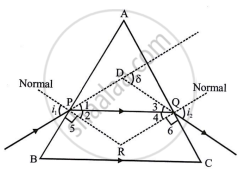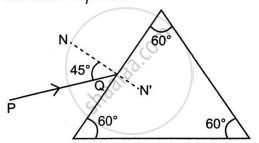Advertisements
Advertisements
प्रश्न
A ray of light incident at an angle of incidence i1 passes through an equilateral glass prism such that the refracted ray inside the prism is parallel to its base and emerges at an angle of emergence i2.
- How is the angle of emergence ‘i2’ related to the angle of incidence ‘i1’.
- What can you say about the angle of deviation in such a situation?
उत्तर
- ∠i1 = ∠i2
and refracted ray is parallel to base.
∠5 = ∠6 = 90°
∵ PQ || BC, ∠APQ = ∠AQP = 60°
∵ ΔABC is equilateral and ∠APQ and ∠AQP are corr. ∠K to ∠B and ∠C
∴ ∠2 = ∠4 ...[∵ 60° + ∠2 = 60° + ∠4]
Similarly, ∠1 = ∠3
∴ ∠1 + ∠2 = ∠3 + ∠4
∴ ∠i1 = ∠i2
∵ ∠i1 = ∠1 + ∠2; ∠i2 = ∠3 + ∠4
∴ Angle of incidence = Angle of emergence is the relation when PQ || Base BC -
The angle of deviation is at its smallest when i1 = i2 and the refracted beam inside the prism is parallel to the base.
δ = i + e - A = i1 + i2- A
∵ i1 = i2 = i
δ = δmin = 2 i - A
For a given prism and given colour of light δmin is unique.
APPEARS IN
संबंधित प्रश्न
Define the term angle of deviation.
Which of the two prism, A made of crown glass and B made of flint glass, deviates a ray of light more?
How does the angle of deviation depend on the refracting angle of the prism?
An object is viewed through a glass prism with its vertex pointing upwards. Draw a ray diagram to show the formation of its image as seen by the observer on the other side of the object.
A ray of light is normally incident on one face of an equilateral glass prism. Answer the following:
Will the light ray suffer minimum deviation by the prism?
A ray of light suffers refraction through an equilateral prism. The deviation produced by the prism does not depend on the ______.
A ray of light incident at an angle of incidence 48° on a prism of refracting angle 60° suffers minimum deviation. Calculate the angle of minimum deviation.
[Hint: δmin = 2i - A]
Explain the phenomenon of dispersion of white light through a glass prism, using suitable ray diagram.
A monochromatic ray of light is incident on an equilateral prism placed at minimum deviation position with an angle of incidence 45° as shown in the diagram?
- Copy the diagram and complete the path of the ray PQ.
- State two factors on which the angle of deviation depends.

State three factors on which the angle of deviation depends.
